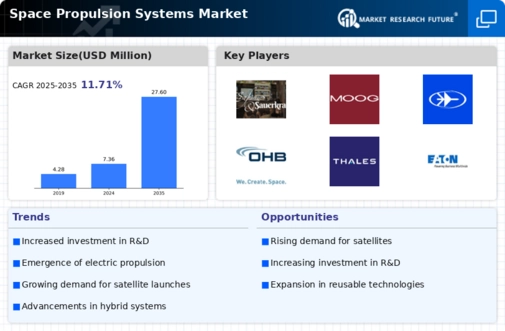Top Industry Leaders in the Space Propulsion Systems Market

Key Companies in the space propulsion systems market include.
Safran S.A. (France)
Space-X (US)
IHI Corporation (Japan)
Northrop Grumman Corporation (US).
Strategies Adopted
Industry news within the Space Propulsion Systems market reflects ongoing trends, regulatory changes, and technological advancements driving the sector forward. News related to successful rocket launches, satellite deployments, and deep space missions showcase advancements in propulsion technology and mission success. Moreover, developments in reusable rocket technology, in-space propulsion testing, and space infrastructure initiatives are frequently covered in industry news, highlighting the importance of innovation and collaboration in advancing space exploration capabilities. Additionally, news related to industry partnerships, government contracts, and international collaborations underscore the global nature of the space propulsion market and the collective efforts aimed at advancing humanity's presence in space.
Current investment trends in the Space Propulsion Systems industry underscore a focus on research and development, infrastructure development, and commercialization of space technologies. Key players are directing investments towards developing next-generation propulsion systems, enhancing launch vehicle capabilities, and expanding space infrastructure to support growing demand for satellite communication, Earth observation, and space tourism. Investments in reusable rocket technology, in-orbit servicing, and lunar exploration missions are prevalent, reflecting the industry's efforts to enable sustainable and affordable access to space. Additionally, strategic investments in talent acquisition, partnerships with academia, and technology transfer initiatives aim to foster innovation and drive long-term growth in the space propulsion market.
Emerging Companies
As the demand for space propulsion systems continues to grow, new and emerging companies are entering the market, contributing to innovation and specialization. Start-ups and specialized firms such as Blue Origin, Rocket Lab, and Relativity Space are gaining recognition by providing innovative propulsion solutions tailored to specific mission needs, such as small satellite launches, lunar landings, and in-space transportation. These companies leverage expertise in additive manufacturing, electric propulsion, and reusable rocket technology to develop cost-effective and scalable propulsion systems that address emerging space industry trends. The industry is witnessing a trend towards the development of green propulsion technologies, such as electric and solar-electric propulsion, aimed at reducing reliance on traditional chemical propulsion systems and minimizing environmental impact.
The overall competitive scenario in the Space Propulsion Systems market is characterized by established aerospace manufacturers, space agencies, and commercial space companies, each navigating the industry with distinct strategies. Market share analysis considers factors such as propulsion technology, performance, reliability, cost, and customer relationships. The industry's responsiveness to evolving mission requirements, technological advancements, and market dynamics further shapes competitiveness. As space exploration efforts continue to expand and commercialize, companies in this sector are focused on delivering innovative, reliable, and cost-effective propulsion solutions that enable the exploration and utilization of space for scientific, commercial, and national security purposes.
Recent News
SpaceX (USA):
Focus on Reusable Launch Vehicles (RLVs): SpaceX successfully completes the 14th flight of its Falcon 9 rocket, a milestone in reusability and cost reduction for space launches.
Development of Starship Super Heavy: Starship, a fully-reusable launch vehicle system, undergoes extensive testing for future Mars missions and lunar landings.
Blue Origin (USA):
Focus on Suborbital Tourism and Research: Blue Origin's New Shepard rocket continues to carry passengers on suborbital space tourism flights, offering unique experiences and research opportunities.
Development of BE-4 Engine: Blue Origin's BE-4 engine, designed for the New Glenn launch vehicle, reaches full thrust in static fire tests, paving the way for future heavy-lift missions.
Rocket Lab (USA/New Zealand):
Focus on Electron Launcher and Small Satellite Deployment: Rocket Lab's Electron launch vehicle continues its successful launch record, deploying small satellites for various commercial and government missions.
Development of Neutron Launcher: Rocket Lab unveils plans for the Neutron launcher, designed for medium-payload missions and lunar cargo delivery.
United Launch Alliance (ULA) (USA):
Focus on Reliable and Proven Launch Vehicles: ULA continues to rely on its Atlas V and Delta IV rockets for critical government and commercial missions, providing high launch success rates.
Development of Vulcan Centaur: ULA's Vulcan Centaur launch vehicle, powered by BE-4 engines, enters advanced assembly stages for its maiden flight.
ArianeGroup (France):
Focus on European Launch Vehicles and Engine Development: ArianeGroup leads the development and production of the Ariane 5 heavy launcher, serving European and international space missions.
Development of Ariane 6 and Themis Engine: ArianeGroup ramps up production of the Ariane 6, a cost-effective launcher for small and medium satellites, and continues testing the Themis engine for future European launch vehicles.
Emerging Trends in Space Propulsion Systems Companies:
Increased focus on reusability and cost reduction in launch vehicles.
Development of next-generation engines with higher efficiency and thrust.
Growing demand for small satellite launch services and constellations.
Exploration of alternative propulsion technologies, such as electric and nuclear propulsion.
Focus on sustainability and minimizing environmental impact of space launches.


